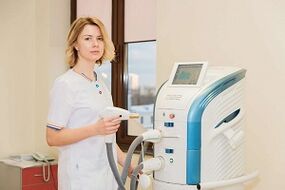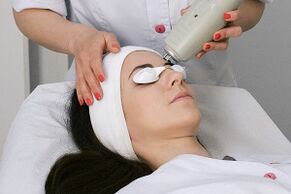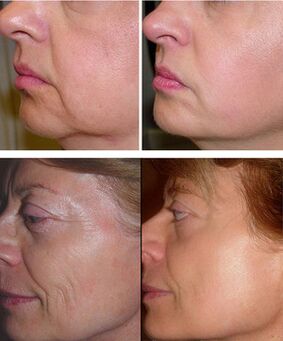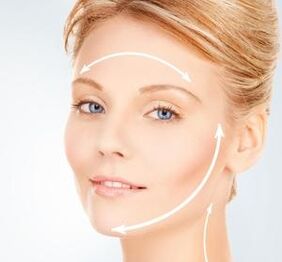
Facial skin inevitably undergoes a natural aging process, which can be resisted by modern cosmetics and cosmetic procedures.
One of these procedures is laser facial rejuvenation - thanks to the technique, the mechanisms of cell rejuvenation and restoration are triggered, the facial skin acquires a new, fresh and clean look.
In cosmetology, a special laser is used to eliminate various skin problems. Fractional laser skin rejuvenation is quite popular - a cosmetological procedure, after which you can increase skin elasticity, eliminate fine and deep wrinkles and tighten the oval of the face. After completing a course of sessions, you will look a few years younger.
The essence and effect of the technique

Laser facial skin rejuvenation is a technique in which laser radiation acts on the skin. For this, a laser source is used - a laser installation - an apparatus in which it is possible to adjust the depth of penetration of the laser beam into the skin, the exposure time and the radiation temperature.
The correct choice of procedure parameters is the most important condition for successful rejuvenation, since at the slightest mistake of the cosmetologist, burns can appear on the face.
Penetrating into the tissue, the laser beam causes slight cell damage, in response to the irritation that has arisen, the cells begin to actively produce collagen and elastin, and the growth of new cells resumes.
Stimulation of regeneration processes leads to a complete renewal of facial skin, its rejuvenation. The second name of the procedure is laser peeling.
Indications and contraindications
The technique is used to eliminate such age-related changes in facial skin:
- Wrinkles.
- Dark spots.
- Blasbiness and sagging.
Also the indications for the procedure are:
- Signs, bumps on the face.
- Signs of acne.
- Unwanted tattoos.
- Keratinization of the skin.
- Enlarged pores.
- Vascular network in the face.
- Stretch marks on the abdomen and legs after pregnancy.
Contraindications to laser peeling are:
- Keloid scars.
- Malignant neoplasms.
- Pregnancy, lactation.
- Herpetic infection during an exacerbation.
- Wounds and scratches on the face.
- Any skin disease.
- Fresh tan.
- Marks.
- Taking medication to treat acne.
In most cases, laser rejuvenation takes place without complications, the first days after the procedure, the patient notices a slight swelling, redness and peeling of the epidermis. These phenomena are normal for laser skin and disappear on their own after a few days.
Possible side effects

But in some cases, the following side effects may develop:
- Persistent redness of the face.
- Worsening of acne.
- Increased skin oil.
- The appearance of hyper- or hypopigmentation.
- Herpetic outbreaks (if the patient has previously been diagnosed with herpes).
- Burns.
- Keeping the border between treated and untreated skin areas.
- Subcutaneous hemorrhage.
The listed side effects disappear for a long time and require additional treatment by a cosmetologist.
Advantages and disadvantages of leather
Fractional peels are widely used due to the following benefits:
- High efficiency, ability to eliminate significant aesthetic imperfections.
- Possibility of performing on any skin type.
- Minimal risk of side effects (burning and hyperpigmentation).
- Without pain.
- Short skin restoration deadlines.
- Ability to treat large areas of skin with one movement.
The disadvantage of fractional skin is its high cost compared to other methods, but given the effectiveness of the procedure, this disadvantage can be considered insignificant.
Types of laser renewal
There are several types of laser rejuvenation, depending on the depth of laser penetration:

- Laser reappearance. . . The laser "works" on the surface layer of the epidermis, layering dead cells. The result of the procedure becomes visible after a week: the skin becomes soft to the touch, fine wrinkles disappear. During the procedure, three types of laser beams are used: erbium, carbon or neodium.
- Laser biorevitalization. . . Radiation penetrates into the deeper layers of the skin, while some cells are destroyed. The technique is harsher than laser reappearance, but gives a strong anti-aging effect. To enhance the effect of the laser, the beautician applies a mixture of nutrients to the skin. After the procedure, deep wrinkles disappear and the contour of the face improves. Recovery after biorevitalization occurs within three months, edema and severe peeling of the epidermis may continue on the face during this period.
- Fractional cortex. . . Fractional laser regeneration is the most effective and at the same time gentle method. The peculiarity of the procedure lies in the fact that the laser beam is broken into many micro-rays, due to which it has a softer effect on the skin. Radiation hits the skin in the form of a network, therefore, the intact areas remain between the foci of cell damage - this contributes to faster tissue regeneration and a stronger rejuvenating effect. The beam power along the fractional shell can be changed using a carbon dioxide or erbium laser.
Stages of the procedure
Before performing the procedure, you should make an appointment with a cosmetologist. The doctor identifies existing problems, asks the patient if there are any contraindications to the procedure, talks about how laser rejuvenation will occur.
If the patient's skin is prone to increased pigmentation, a whitening cream is prescribed a few days before the rejuvenation session. The patient should know that before the procedure, he should not engage in sports, heavy physical work or drink alcoholic beverages.
Fractional skin performance sequence:
- The face is cleansed using conventional cosmetics.
- Anesthetic cream is applied to the skin.
- After a few minutes, the anesthetic is washed off, a gel is applied to facilitate sliding of the nozzle of the fractional apparatus. The glasses are placed in the patient's eyes.
- The doctor moves the muzzle over the face, constantly touching each area with a laser.
- The treatment lasts 15-60 minutes, after which a soothing cream is applied to the skin.
In total, you have to go through 3-4 procedures, the rest between them is 1-2 months.
Home skin care

After laser treatment, swelling, redness, peeling and itching appear on the skin and later crusts form. Patients should follow these recommendations:
- Apply a cold compress to the face to ease the swelling.
- Apply anti-inflammatory and soothing creams to the skin (prescribed by the beautician).
- Use a sunscreen for your face before you go out.
- Do not go to the bath, sauna or take a hot bath for two weeks after the procedure.
- Do not use scrubs; apply cosmetic products only with the permission of the cosmetologist.
- Do not remove crusts formed to prevent the appearance of scars on the face.
If the laser rejuvenation is performed by a highly qualified specialist and the patient follows all the recommendations of the doctor, the result of the procedure satisfies with an excellent cosmetic effect.














































































